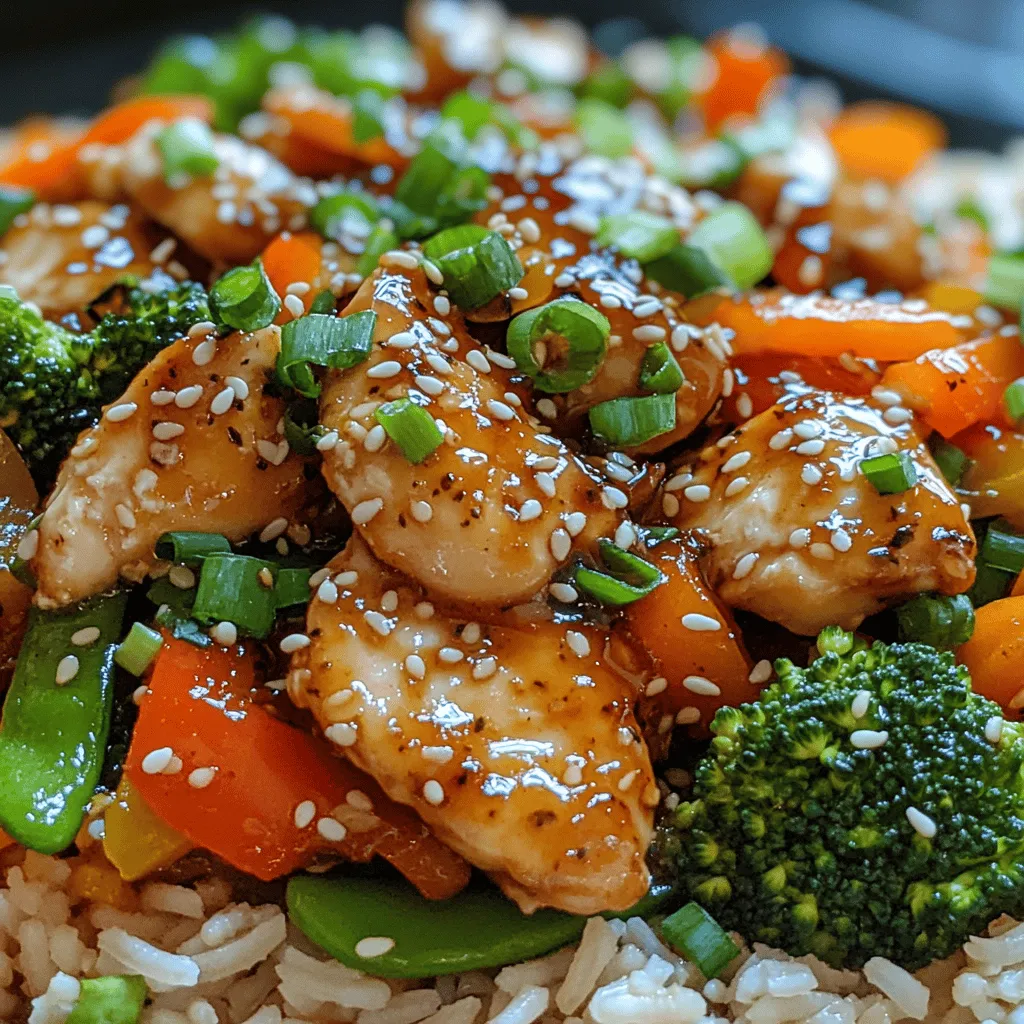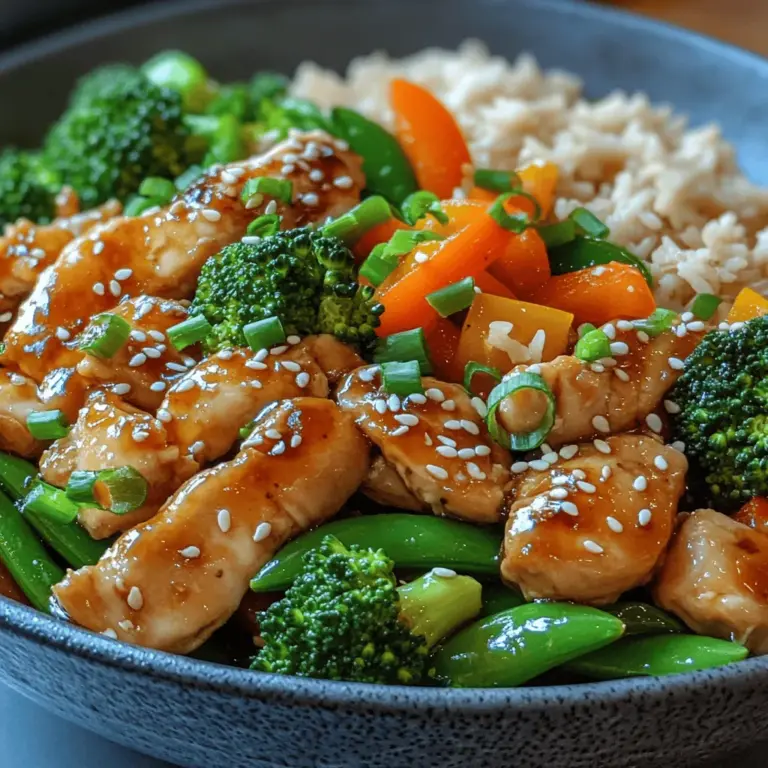Introduction
Stir-frying stands out as one of the most efficient and nutritious cooking methods available, celebrated for its ability to combine vibrant flavors and preserve the nutritional integrity of ingredients. This cooking technique, which quickly cooks food over high heat, ensures that vegetables remain crisp and colorful while proteins are perfectly tender. Among the myriad of stir-fry options, the Vibrant Chicken Veggie Stir-Fry shines brightly, offering a delightful medley of colors and textures that appeal to both the eyes and the palate.
This recipe is a masterpiece of simplicity and health, making it an ideal choice for busy weeknights or when you’re looking to whip up a wholesome family meal. Packed with lean protein from chicken and a plethora of fresh vegetables, this dish not only satisfies hunger but also provides essential nutrients that contribute to overall well-being. The combination of fresh bell peppers, crunchy snap peas, tender carrots, and nutrient-rich broccoli creates a visually stunning presentation while delivering a robust flavor profile that is sure to please.
Understanding Stir-Frying: A Culinary Technique
Stir-frying has its roots in ancient Asian cooking, where it evolved as a method to prepare quick meals using minimal fuel. This technique originated in China, and its popularity has spread across the globe, becoming a staple in many cultures’ culinary repertoires. The key to successful stir-frying lies in its method: ingredients are cooked quickly in a small amount of oil over high heat, allowing them to seal in their flavors and nutrients.
One of the essential tools for stir-frying is a wok, a versatile cooking vessel designed with a round bottom that promotes even heat distribution. However, a large skillet can also suffice if a wok is unavailable. The high sides of a wok help contain the ingredients while tossing, ensuring that everything cooks evenly without spilling over. A spatula or wooden spoon is crucial for stirring and flipping the ingredients, allowing for quick and efficient cooking.
Ingredients Breakdown
Chicken
When crafting the Vibrant Chicken Veggie Stir-Fry, boneless, skinless chicken breast is the star protein. This cut of meat is favored for its lean quality, making it an excellent source of protein without the excess fat found in other cuts. With approximately 31 grams of protein per 100 grams, this chicken breast not only aids in muscle repair and growth but also keeps you feeling satisfied longer. Its mild flavor makes it incredibly versatile, taking on the essence of the marinades and seasonings, which enhances the overall dish.
Vegetables
The selection of vegetables in this stir-fry is not just for aesthetics; each ingredient contributes unique health benefits that elevate this dish’s nutritional profile.
– Snap Peas: These vibrant green pods are rich in vitamins A, C, and K, as well as fiber. Their natural sweetness and crisp texture add a delightful crunch to the stir-fry.
– Bell Pepper: Available in various colors, bell peppers are packed with antioxidants and vitamin C, supporting the immune system and skin health. Their sweet, juicy flavor complements the other ingredients beautifully.
– Carrot: Known for their beta-carotene content, carrots are excellent for eye health. They also provide a satisfying crunch and a touch of natural sweetness to the dish.
– Broccoli: This superfood is loaded with vitamins C and K, fiber, and a range of phytonutrients that may have cancer-fighting properties. Its robust texture and earthy flavor balance the sweetness of the other vegetables.
Aromatics and Seasonings
To elevate the flavor of the Vibrant Chicken Veggie Stir-Fry, the inclusion of aromatics such as garlic and ginger is essential. Garlic adds a pungent, savory note, while ginger contributes warmth and a hint of spice, creating a complex flavor foundation for the dish.
Low-sodium soy sauce serves as the primary seasoning, providing that quintessential umami flavor that complements the chicken and vegetables. Using a low-sodium version helps keep the dish healthier without sacrificing taste. Sesame oil is another vital component, offering a nutty richness that rounds out the overall flavor profile. For those who enjoy a touch of sweetness, adding a drizzle of honey or maple syrup can create a delightful contrast to the savory elements.
Step-by-Step Preparation
Preparing the Chicken Marinade
Marinating the chicken is a crucial step in this stir-fry recipe. It not only infuses the meat with flavor but also enhances its tenderness, resulting in a more enjoyable texture. For optimal results, marinate the chicken for at least 30 minutes, allowing the flavors to penetrate the meat. A simple marinade can be made by combining soy sauce, sesame oil, minced garlic, and ginger in a bowl. Ensure each piece of chicken is well-coated, then cover and refrigerate while you prepare the vegetables.
Cooking the Chicken
Once the chicken has marinated adequately, it’s time to cook it. Heat a wok or large skillet over high heat and add a small amount of oil—preferably a high smoke point oil like canola or peanut oil. When the oil is shimmering, carefully add the marinated chicken to the pan. It’s important not to overcrowd the pan, as this can lead to steaming rather than stir-frying. Cook the chicken for about 5-7 minutes, stirring frequently, until it is golden brown and fully cooked through. Remove the chicken from the pan and set it aside, allowing the flavors to develop while you move on to the vegetables.
This initial preparation sets the stage for a delightful and nutritious meal that is both satisfying and quick to prepare, embodying the essence of what makes stir-frying a beloved cooking method around the world.

Sautéing the Chicken
To achieve the perfect chicken for your stir-fry, begin by heating a large non-stick skillet or wok over medium-high heat. Add a tablespoon of oil (canola or vegetable oil works well due to their high smoke point) and let it heat until shimmering. This is crucial for ensuring that the chicken sears beautifully, locking in moisture and flavor.
When the oil is hot, add the sliced chicken breast in a single layer, ensuring that the pieces do not overcrowd the pan. Overcrowding can lead to steaming rather than browning, which can affect both texture and flavor. You should sauté the chicken for about 5-7 minutes, turning occasionally until it is golden brown and cooked through. For best results, use a meat thermometer to ensure the internal temperature reaches 165°F (75°C).
To prevent the chicken from drying out, refrain from cooking it for too long. If your chicken is cooking too quickly or browning unevenly, reduce the heat slightly. If desired, you can add a splash of chicken broth or water to the pan to create steam, which will help keep the chicken moist while it finishes cooking. Once done, remove the chicken from the pan and set it aside on a plate. This will allow the residual heat to continue cooking the meat slightly without risking overcooking.
Stir-Frying the Vegetables
Next, it’s time to bring life and color to your stir-fry with a variety of vegetables. The key to perfect stir-fried vegetables is to maintain their crunch and vibrant colors. Begin by preparing the vegetables—wash and chop them into uniform bite-sized pieces to ensure even cooking.
Start with the vegetables that take the longest to cook. For this recipe, consider using bell peppers, broccoli florets, snap peas, and carrots. Heat a bit more oil in the same pan over high heat, adding the harder vegetables first. Sauté them for about 2-3 minutes, stirring constantly to prevent burning.
After the initial sauté, add softer vegetables like zucchini or bok choy. These should only take about 1-2 minutes to cook. The goal here is to keep the vegetables crisp and colorful, so be mindful not to overcook them. A quick tip: keep the vegetables moving in the pan. This technique not only helps them cook evenly but also prevents them from clumping together or sticking to the pan.
Consider adding a splash of soy sauce or a sprinkle of salt towards the end of cooking for additional flavor. This not only enhances the taste but also helps to bring out the natural sweetness of the vegetables. Once they are bright and tender-crisp, remove them from the heat.
Combining Ingredients
Now that you have perfectly sautéed chicken and vibrant vegetables, it’s time to combine them. Return the cooked chicken to the skillet with the vegetables. This is where the magic happens—ensuring that the flavors meld together beautifully.
Add in any additional sauces or seasonings at this stage. A mix of soy sauce, oyster sauce, or even a touch of sesame oil can elevate the dish significantly. Toss everything together gently but thoroughly, allowing the sauces to coat the chicken and vegetables evenly.
Timing is crucial here; you want to ensure that the chicken is heated through without overcooking the vegetables. Stir-frying should take no more than 1-2 minutes at this stage. The residual heat will warm the chicken while keeping the vegetables crisp and colorful.
Serving Suggestions
Garnishing the Dish
Presentation is key, especially with a dish as vibrant as this stir-fry. Once plated, consider garnishing with finely sliced green onions and a sprinkle of sesame seeds. Not only do these garnishes add an aesthetic appeal, but they also contribute an extra layer of flavor and texture to the dish. Green onions offer a mild onion flavor that complements the savory elements, while sesame seeds add a pleasant crunch.
Accompaniments
For a well-rounded meal, serve your Vibrant Chicken Veggie Stir-Fry over a bed of cooked brown rice or quinoa. Both options provide a nutritious base, adding fiber and healthy carbohydrates that balance out the protein-rich chicken and nutrient-dense vegetables. Brown rice offers a nuttier flavor and a chewier texture, while quinoa is a fantastic gluten-free option and boasts a complete amino acid profile.
Nutritional Benefits of Vibrant Chicken Veggie Stir-Fry
This dish is not only colorful and delicious but also packed with nutritional benefits. The chicken provides a lean source of protein, essential for muscle growth and repair. The variety of vegetables contributes a wide range of vitamins and minerals, including vitamin C from bell peppers and broccoli, beta-carotene from carrots, and fiber from snap peas and zucchini.
The overall nutritional profile of this stir-fry makes it a great choice for various dietary needs. It is suitable for those looking to lose weight, as it is low in calories while being high in nutrients, helping you feel full and satisfied. This dish also fits well into a balanced diet aimed at increasing vegetable intake, making it a perfect addition for anyone looking to improve their overall health.
Variations and Customization
One of the best aspects of stir-fry is its versatility. Feel free to customize the recipe according to your preferences or dietary restrictions. For a vegetarian or vegan option, tofu or tempeh can be used as a protein substitute. Simply press and cube the tofu, sautéing it until golden before adding to the vegetables.
If you prefer seafood, shrimp makes an excellent addition and cooks quickly, ensuring it remains tender. For meat lovers, consider substituting chicken with beef or pork, adjusting cooking times accordingly to prevent overcooking.
Vegetable options are also limitless—think about adding mushrooms, bok choy, or even fresh spinach to enhance the dish’s nutritional value. The key is to maintain a balance of colors and textures for a visually appealing and flavorful stir-fry.
Conclusion
The Vibrant Chicken Veggie Stir-Fry is more than just a quick meal; it is a celebration of flavors, colors, and nutrition. This recipe offers a superb balance of protein, carbohydrates, and an array of essential vitamins and minerals, making it a versatile addition to any home cook’s repertoire.
Whether you’re aiming to impress dinner guests or simply want a healthy, delicious meal for yourself and your family, this stir-fry is sure to satisfy. Plus, its adaptability allows you to get creative based on seasonal vegetables or personal preferences. Embrace the art of stir-frying and enjoy a dish that’s not only good for your taste buds but also for your health. Happy cooking!


